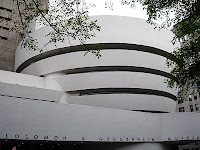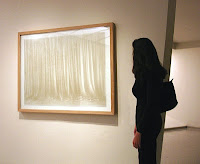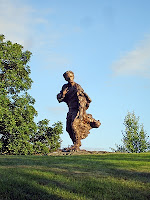
My guests had never been to an art gallery before so I felt it necessary to define for them what the function of a gallery is. I proceeded to tell them that like a museum, a gallery is place to see works of art, such as paintings, drawings, photographs, installations, and/or sculptures. The primary difference between a museum and a gallery, however, is that galleries do not charge an entry fee. There are hundreds of galleries in New York City, all with their own areas of interest and specialties. They put together exhibitions (also known as shows) that usually last for several weeks or for several months. These exhibitions can consist of one artist's work (a solo exhibition/show), or many different artists works displayed at the same time (a group exhibition/show).

Our first stop was to L&M Arts, a gallery on East 78th street that showcases modern and contemporary art. There, we saw a solo- exhibition of works by George Segal (1924- 2000), a 20th century American sculptor. Segal created larger than life sized human forms performing commonplace, easily recognizable activities. We saw a group of figures riding the bus, sitting on a bench, and walking in an intersection. The white plaster forms were seemingly anonymous. The lack of color and absence of detailed facial features made it apparent that these figures could be any one of us. There was no attempt made by the artist to depict age or to glamorize his subjects. Rather, he represented the average person.

We then visited Michelle Rosenfeld gallery, on East 79th street. Here, we viewed the work of two Asian contemporary artists. First we saw a mixed media piece titled Aggregation 06-AU037 by the Korean artist Kwang Young Chun (b. 1944). Mixed media refers to a piece of art that is created using more than one material. In Aggregation, the primary material that Chun used was paper from discarded Korean books that he found. I made the claim that to me, his work looks like sculpture on the wall- another word for this is a wall relief. Although it is mounted on the wall like a painting, its elements project off the canvas and out into the viewer’s space.
Afterwards we saw a painting titled Eye Ball White, 2001 (acrylic on canvas mounted on wood) by Japanese artist Takashi Murakami. Many people would describe Murakami’s art as cartoon-like and find it amusing. His works are very popular- museums and galleries all over the world have given Murakami solo exhibitions and often include him in group shows. Murakami paints in his own unique style, which has been coined by the term Superflat. Paintings in the Superflat method are composed of cartoon like characters that are superimposed on flat color backgrounds. The artist intentionally took familiar images from Japanese TV animation and removed them from their typical pop-culture context. We discussed how the center eye- ball in Eye Ball White appears three- dimensional. We decided that Murakami achieved this effect by painting each eye not only a different size, but also at different angles, with some receding into space and some projecting forward.
To see examples of the artists work mentioned in this post, visit the websites below
http://www.artcyclopedia.com/gallery/segal_george.html
http://www.lmgallery.com/exhibitions/george-segal/
http://www.artnet.com/artist/425130245/chun-kwang-young.html
http://www.takashimurakami.com/





























